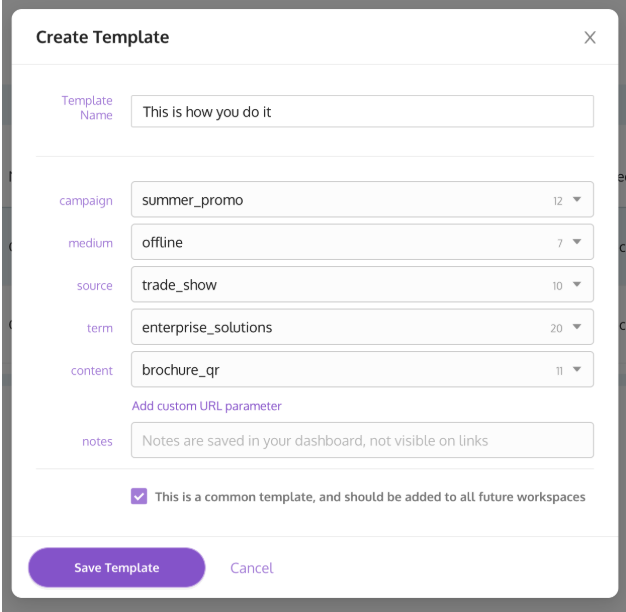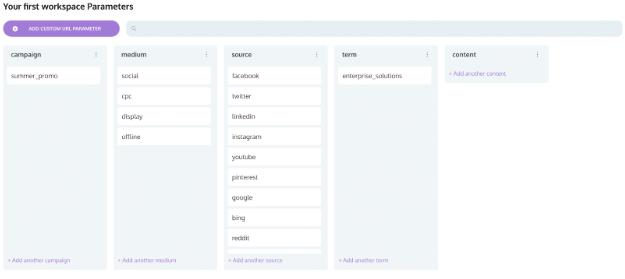QR codes are everywhere. Ads, packaging, posters, products, you name it. They’re easy to slap on, but hard to get right. If you’re not seeing results, it’s probably not the code’s fault. It’s the tracking.
Most QR code campaigns fail at marketing attribution. The scan happens, but the data never makes it into your CRM or analytics. This post breaks down exactly where things go wrong, and what you can do instead.
Executive summary
QR code attribution breaks down when UTMs are inconsistent, tracking gets stripped, or codes don’t get scanned.
To fix it:
- Use dynamic QR codes with clean, branded design
- Apply consistent, enforced UTM conventions
- Shorten links properly and don’t lose tracking in the process
- Check that redirects and destination pages actually work
- Make sure your tools can follow users beyond the first scan
Fix the basics, and you’ll stop losing visibility before the funnel even starts.
How QR Code Attribution Actually Works
When a QR code is scanned, the user’s device reads the code and acts on the embedded data. Typically, that means opening a URL in a browser.
With a static QR code, users get sent directly to a fixed URL. If that URL has UTMs, you can see where the traffic came from and build an attribution trail. But if they bounce before the page loads, or the UTMs get stripped, you lose the trail.
Dynamic QR codes solve this. They route scans through a short redirect URL. This lets you log the scan itself, including device, timestamp, and general location, even if the user never reaches the final destination.
This extra step gives you two layers of tracking: scan data and traffic data.
Pair that with structured UTMs and you get much closer to full-funnel marketing attribution. That is, if your QR codes actually get scanned in the first place.
Why Do QR Codes Fail?
Early QR marketing failed so frequently that it became a butt of jokes. And most of the issues that plagued those early efforts still trip up campaigns today.
These aren’t necessarily attribution-specific. But if your QR codes don’t get scanned or don’t lead where they need to, you’ll never get any attribution data out of them at all.
No Reason to Scan
If there’s no clear benefit, people won’t bother. Give them something they want: exclusive content, discounts, or a helpful experience.
No Clear CTA
Tell people exactly what to do and what they’ll get. “Scan to watch the demo” beats a lone code on a poster.
Poor Scanability
If your code is too small, too far away, or hard to scan, it won’t get scanned. Make it clean, clear, and appropriately sized for the context.
For close-up scans on brochures, tables, and booths, it should be at least one inch square (or 2cm2). For billboards and posters, it’ll need to be much larger.
Generic Design
Plain black-and-white codes look untrustworthy or unfinished. Branded codes with logos and brand colors are up to 80% more effective.
Lack of Testing
If you haven’t tested your QR code on different devices and in different conditions, you’re taking a risk. Scan it yourself, check the destination, and ensure it loads fast and looks good.
Why Attribution Fails
Even with a perfect scan, attribution can fall apart if the underlying systems aren’t set up correctly. Here are a number of ways that marketing attribution can go south on you.
Static Instead of Dynamic QR Codes
Static codes can’t be edited and don’t support scan-level tracking. With dynamic codes, you can:
- Track scan behavior
- Run A/B tests on design or CTA
- Change destinations without reprinting
- Modify UTM parameters for better data hygiene
This is more of a missed win than a fail, but it’s worth mentioning. Without these things, your attribution will be less accurate and complete.
Redirect Problems
Redirects can cause attribution failures when:
- They’re too slow or broken, leading to visitor drop-off. If this happens after they scan the code but before arriving at the destination URL, the discrepancy will show up in your scan tracking and UTM tracking data. Unless…
- They strip UTM parameters. Misconfigured redirects can strip UTMs from URLs, making them invisible for the purposes of attribution.
- They point to the wrong destination. Redirecting to the wrong URL can also prevent accurate tracking.
Dynamic QR codes fix a lot of these issues.
Website or Landing Page Errors
If tracking scripts don’t fire, the visit doesn’t get recorded. JavaScript errors, ad blockers, or broken pixels can interfere. Regular QA using Google Tag Manager or similar tools is essential.
Privacy and Tracking Restrictions
Data protection laws like GDPR and CCPA can block or anonymize some tracking URLs, so you need to use Consent Management Platforms (CMPs) to make sure you’re compliant. Dynamic QR codes can help circumvent some tracking blocking from things like Intelligent Tracking Protection (ITP) from Apple’s Safari.
The solution is a switch to first-party data like:
- On-site behavior
- CRM activity
- Email and app interactions
Also watch for URL shorteners that strip or mask UTM parameters. Use branded, custom short links to keep attribution intact.
URL Shortening, Advanced Bulk UTM Building and Management, and Dynamic QR Codes, All in the Same Place?
Solve top-of-funnel marketing attribution at a stroke.
You’re Not Using UTMs Correctly
Even when marketers use UTMs, they often use them inconsistently. That ruins data quality.
The first issue is UTM taxonomy mistakes. UTMs are case-sensitive and space-sensitive. “Facebook,” “facebook,” and “fb” all get treated as different sources in analytics tools.
Check out these two URLs:
The same, right?
Look again. Nearly every UTM parameter contains a typo or some other error. ‘Offline’ is capitalized in one, but not the other, for instance. These will appear in tracking as two different parameters. Making mistakes like this is easy. In fact, when several people are working with large numbers of UTM parameters, it’s inevitable.
How to Fix UTM Fails
If your attribution data is a mess, start with your UTMs. Bad naming, inconsistent formats, and manual errors will ruin even the best campaigns. Here’s how to clean things up.
Use Clear, Consistent Conventions
Set standards and stick to them. That includes:
- Force lowercase text
- Choose one word separator: dashes, underscores, or plus signs
- Use consistent vocabulary: never mix terms like “social” and “social_media”
- Keep campaign names consistent year over year.
This alone will save you from the most common (and painful) reporting issues.
Use a UTM Builder That Enforces the Rules
Templates let you build once and reuse across campaigns. The right builder should let you:
- Control who can access which templates
- Set required fields for each parameter
- Block bad values (no more rogue plus signs)
- Provide pre-approved options via dropdowns
- Lock in parameter structure at the workspace level
When people can only choose from the right options, you eliminate typos, casing errors, and off-label improvisation.
Automate with Dynamic Variables
At scale, hand-building UTMs isn’t just tedious, it’s risky. Instead, create dynamic templates that auto-generate UTMs based on campaign inputs. For example:
The process looks like this. Suppose you want to create a campaign convention like:
| utm_campaign= | {{campaign name}}-{{sales region}}-{{goal}} |
| utm_medium | |
| utm_source | mailchimp |
You could build new custom UTMs every time, but it will become time-consuming very fast if you’re using UTMs at serious scale. Fortunately automating it in a solid UTM builder is not hard. You use custom dynamic variables chained together. You should be able to create conventions using parameters, attributes, and a combination of both. The difference between them is that a parameter shows up on the URL, but attributes only show up on the dashboard and are not part of the link itself.
Your Attribution Is Siloed
Even if your QR code setup is perfect, you’re probably only seeing the top of the funnel. You know someone scanned a code and landed on a page, but lose them as they move into a different area of the funnel that belongs to a different tool.
In most stacks, attribution data lives in silos. The person who scanned your booth QR code might be the same one who opened an email yesterday and booked a demo next week. But if your tools don’t talk to each other, you won’t know. Without end-to-end attribution it’s hard to say if your QR code marketing activities even made any money.
You can fix this with APIs to some extent to pass data from tool to tool. The most effective solution is to use a CDP like Segment to sync your marketing attribution efforts and create a single customer view across all funnel stages and channels.
Takeaways
QR code attribution breaks down for a few key reasons:
- Bad code design that no one wants to scan
- Tracking issues like stripped UTMs or broken redirects
- Inconsistent, messy UTM parameters
- Siloed data that makes full-funnel attribution impossible
To fix it:
- Use dynamic, branded QR codes
- Add clean, consistent UTMs (preferably built from enforced conventions, not spreadsheets)
- QA your redirects and landing pages regularly
- Unify your data with tools that bridge gaps between platforms
And remember, attribution isn’t just about tracking. It’s about connecting the dots all the way to revenue. Start by making your QR codes worth scanning, and making sure you can see what happens when the scans happen.
Make QR Attribution Work Like It’s Supposed To
Talk to us about our UTM builder. Start Your Free Trial of UTM.io


